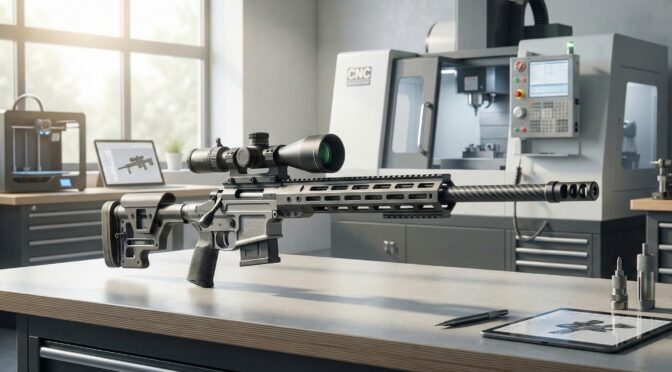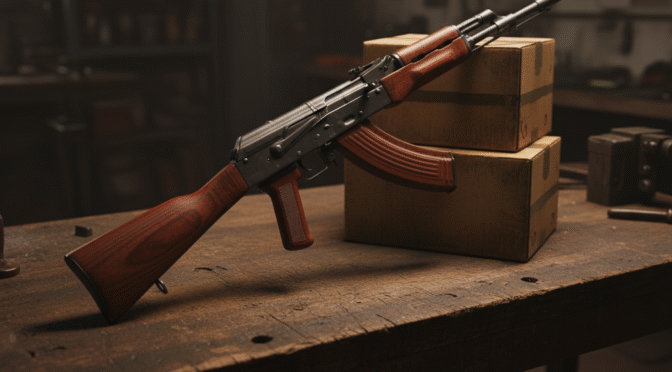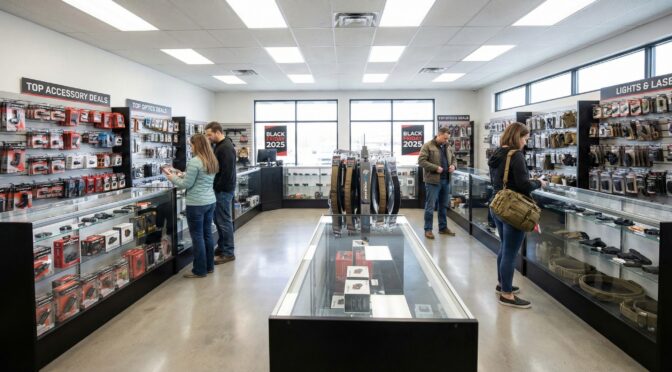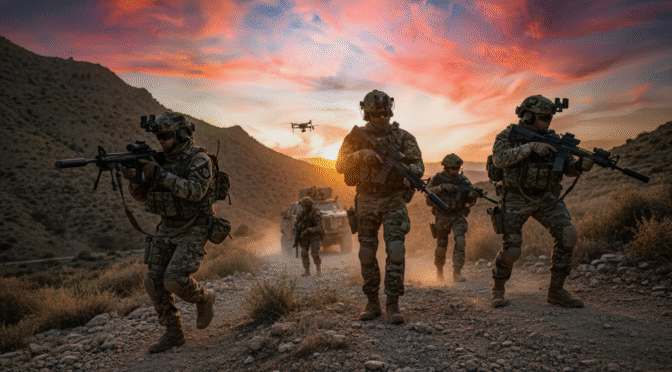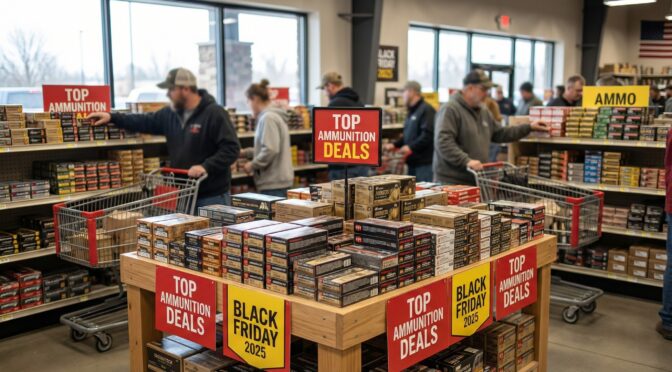The twenty-five-year period between 2000 and 2025 represents the most significant paradigm shift in the history of consumer small arms performance. At the turn of the millennium, the concept of a “factory precision rifle” was largely an oxymoron. The industry standard for a production hunting rifle was colloquially termed “minute of deer”—a grouping capability of roughly 2 to 3 inches at 100 yards. Sub-Minute of Angle (MOA) performance, defined as a grouping of roughly 1.047 inches or less at 100 yards, was almost exclusively the domain of custom gunsmithing, requiring expensive labor-intensive processes such as action truing, glass bedding, and hand-lapped barrels.
By 2025, this landscape has inverted. Sub-MOA performance is no longer an aspirational goal for the elite; it is the baseline entry requirement for even budget-tier rifles. This report investigates the hypothesis that the roster of factory rifles claiming and delivering MOA or better accuracy has grown consistently year-over-year. The analysis confirms this hypothesis, identifying a distinct upward trend driven not by a single “magic bullet” but by a convergence of advanced manufacturing technologies, material sciences, and a fundamental shift in engineering philosophy.
From the perspective of a small arms analyst, this transformation is driven by three primary vectors:
- The CNC & Automation Revolution: The shift from manual machining to multi-axis Computer Numerical Control (CNC) and Electrical Discharge Machining (EDM) allowed “blueprinted” tolerances to be achieved on assembly lines.1
- The “Barrel Nut” and Chassis Paradigm: The widespread adoption of modular headspacing systems (the barrel nut) and chassis-based bedding eliminated the two largest sources of inaccuracy: human error in assembly and environmental warping of wooden stocks.3
- The Ballistic Renaissance: The symbiosis between rifle manufacturers and ammunition makers, specifically regarding cartridge designs like the 6.5 Creedmoor that were engineered for concentricity rather than legacy feeding geometry.5
This report provides an exhaustive, year-by-year documentation of this evolution, analyzing the specific factory rifles that drove this change and the engineering causalities behind their performance.
1.0 The Engineering Baseline: The State of the Art (Pre-2000)
To understand the magnitude of the 2000–2025 evolution, one must first dissect the technological limitations of the late 20th century. In 1999, the “Big Three” American manufacturers—Remington, Winchester, and Ruger—dominated the bolt-action market. Their manufacturing processes were rooted in mid-century tooling.
1.1 The “Craft” Barrier
In the pre-2000 era, accuracy was a function of labor. A receiver forged from steel often warped slightly during heat treatment. To make it accurate, a gunsmith had to “true” it—mounting it in a lathe and re-cutting the face, threads, and locking lugs to ensure they were perfectly perpendicular to the bore. Factory rifles, produced on manual or early automated lines, simply could not hold these tolerances cost-effectively. Consequently, a Remington Model 700 from 1998 might shoot 0.75 MOA, or it might shoot 2.5 MOA, depending entirely on the stack-up of tolerances on that specific Monday morning.7
1.2 The Bedding Problem
Most rifles utilized wooden stocks. While aesthetically pleasing, wood is hygroscopic; it absorbs and releases moisture, expanding and contracting. This movement exerted inconsistent pressure on the barrel, altering the harmonic vibration nodes shot-to-shot. “Glass bedding”—the manual application of epoxy to create a stable interface—was a custom aftermarket procedure, not a factory standard.8
1.3 The Liability Trigger
Perhaps the greatest hindrance to practical accuracy was the trigger. Following decades of litigation, factory triggers in the 1990s were notoriously heavy (often 6–8 lbs) and possessed significant “creep” (gritty travel before the break). While a heavy trigger does not mechanically degrade the rifle’s intrinsic precision, it drastically degrades the shooter’s ability to extract that precision by introducing muscle tremors and torque during the long, heavy pull.9
2.0 Phase I: The Trigger Revolution and Global Influence (2000–2005)
The early 2000s did not see an immediate explosion of new models, but rather the introduction of two specific platforms that would eventually force the entire industry to pivot.
2000–2002: The Calm Before the Storm
In these opening years, the market remained largely stagnant. The precision shooter’s primary option was still the Remington 700 Varmint Synthetic (VS) or Police (PSS) models. These featured heavy barrels and aluminum bedding blocks within H-S Precision stocks, offering a glimpse of what was to come. However, the pricing ($800+) placed them out of reach for the average hunter.
The Savage Sleeper
The Savage Model 10/110 FP (Law Enforcement) existed during this time as a budget alternative. It utilized a floating bolt head design. Unlike a Mauser-style bolt, which is a single rigid piece that requires perfect receiver alignment, the Savage bolt head was pinned loosely to the bolt body. This allowed the lugs to “float” and self-center in the receiver recesses, essentially self-correcting for minor misalignment. While crude, it was effective, often out-shooting rifles twice the price.10
| Year | Brand | Model | Caliber | Avg Street Price (Adj.) | Accuracy Sentiment |
| 2000 | Remington | 700 VS | .308 Win | $750 | The benchmark. Required trigger work. |
| 2001 | Savage | 110FP | .308 Win | $450 | The “ugly duckling” that could shoot. |
| 2002 | Winchester | Model 70 Stealth | .22-250 | $800 | Heavy, controlled feed, accurate. |
2003: The Watershed Moment
The year 2003 stands as the single most critical inflection point in modern factory rifle history due to two releases: the Savage AccuTrigger and the Tikka T3.
The Savage AccuTrigger
Savage Arms CEO Ron Coburn challenged his engineers to solve the liability trigger problem. The result was the AccuTrigger.
- Mechanism: The system utilized a secondary “safety blade” (the AccuRelease) embedded within the trigger shoe. This blade blocked the sear from disengaging unless the shooter’s finger was centrally placed and depressing the trigger.
- Implication: This mechanical safety allowed Savage to lower the sear engagement weight safely. If the rifle was dropped or the sear jarred loose, the safety blade would catch the firing mechanism. Savage demonstrated this by dropping rifles from 20 feet onto concrete without discharge.13
- Market Impact: Suddenly, a $400 factory rifle had a crisp, user-adjustable 2.5 lb trigger. This destroyed the excuse that “factory rifles need heavy triggers for safety,” forcing every competitor to develop a similar “bladed” trigger system within the decade.
The Tikka T3
Simultaneously, Sako of Finland (under Beretta ownership) introduced the Tikka T3 to the US market.
- Manufacturing Philosophy: The T3 was designed for manufacture (DFM). It utilized a broached receiver (extremely smooth raceways) and a two-lug bolt. Crucially, it used Cold Hammer Forged (CHF) barrels produced on the same machinery as the high-end Sako 85 rifles.
- The Guarantee: Tikka offered a written 1 MOA guarantee (3 shots at 100 yards). At a price point of roughly $450–$500, this was unheard of.
- Reception: While American traditionalists mocked the extensive use of polymer (the “plastic” trigger guard and magazine), the accuracy was undeniable. The rigid receiver (small ejection port) and high-quality barrel made sub-MOA performance routine.
| Year | Brand | Model | Caliber | Avg Street Price | Accuracy Sentiment |
| 2003 | Savage | Model 10 w/ AccuTrigger | Various | $500 | Revolutionary. User-adjustable safety. |
| 2003 | Tikka | T3 Lite | Various | $480 | The new standard for lightweight precision. |
2004–2005: The “Binning” Strategy
Following 2003, manufacturers began to recognize that accuracy was a marketable commodity. Weatherby, a company famous for velocity over precision, adapted its strategy with the Vanguard line.
Weatherby Vanguard Sub-MOA
The Vanguard was manufactured by Howa in Japan. Howa’s cold hammer forging process produced barrels with excellent consistency. Weatherby began testing barreled actions at the factory. Those that shot particularly tight groups (0.99″ or less) were segregated, placed in upgraded stocks, and sold as “Range Certified” or “Sub-MOA” models with a signed target.
- Insight: This “binning” strategy admitted that while their manufacturing was good, it wasn’t yet consistent enough to guarantee every rifle. It monetized the statistical outliers of the production curve.
| Year | Brand | Model | Caliber | Avg Street Price | Accuracy Sentiment |
| 2004 | Howa | 1500 Varminter | .223 Rem | $550 | “Japanese Weatherby.” Heavy and stable. |
| 2005 | Weatherby | Vanguard Sub-MOA | .257 Wby | $750 | Verified accuracy with factory target. |
3.0 Phase II: The Bedding Block and Rifling Evolution (2006–2010)
As the trigger issue was resolved (with competitors scrambling to copy Savage), engineering attention shifted to the interface between the metal action and the stock. The era of pillar bedding and proprietary rifling began.
2006–2007: 5R Rifling and Integral Bedding
Thompson Center Icon
In 2007, Thompson Center (T/C) released the Icon, a rifle that failed commercially but was an engineering triumph.
- 5R Rifling: T/C brought 5R rifling to mass production. Unlike standard 4- or 6-groove rifling with 90-degree corners, 5R uses 5 lands with angled sides. This reduces jacket deformation and powder fouling, typically resulting in higher consistency and velocity. Previously, this was the domain of custom barrel makers like Boots Obermeyer.
- Interlok Bedding: The Icon featured an integral aluminum bedding block machined into the stock, creating a rigid platform that mimicked custom glass bedding.
Remington 700 SPS (Special Purpose Synthetic)
Replacing the ADL/BDL hierarchy, the SPS became the ubiquitous “base model” 700. While the stock was a flimsy injection-molded piece that often touched the barrel (destroying harmonics), the “barreled action” remained a favorite for builders. The Varmint models, despite the cheap stock, often shot well due to the stiffness of the heavy barrel profile.
| Year | Brand | Model | Caliber | Avg Street Price | Accuracy Sentiment |
| 2006 | Remington | 700 SPS Varmint | .308 Win | $600 | Great action, terrible stock. |
| 2007 | Thompson Center | Icon | .30 TC | $800 | Advanced engineering (5R), proprietary caliber failed. |
2008: The Economic Crunch and Design Innovation
The 2008 financial crisis forced a bifurcation in the market: premium rifles had to offer more value, and budget rifles had to cut costs without losing performance.
Marlin XL7: The “Franken-Rifle” Success
Marlin, a lever-action company, introduced the XL7 bolt action. It was a masterclass in “borrowed” engineering:
- The Barrel Nut: Like Savage, Marlin used a barrel nut. This allowed them to set headspace perfectly on the assembly line without precision machining the barrel shoulder.
- The Pro-Fire Trigger: A direct clone of the AccuTrigger.
- The Result: A $300 rifle that consistently shot MOA, embarrassing rifles costing three times as much. It proved that the “barrel nut” system was the secret to cheap accuracy.
Browning X-Bolt
Browning replaced the A-Bolt with the X-Bolt. To justify its premium price ($800+), Browning glass-bedded the action at the recoil lug and tang at the factory. This was a manual process usually reserved for custom smiths. They also introduced the “Feather Trigger,” a three-lever design that eliminated creep.
Winchester Model 70 (FN Production)
After a hiatus, the Model 70 returned, manufactured by FN Herstal in South Carolina. These rifles benefited from FN’s military-grade Cold Hammer Forging (CHF) technology. The new “MOA Trigger” was an enclosed, single-stage unit with zero take-up, replacing the open design of the pre-64 style.
| Year | Brand | Model | Caliber | Avg Street Price | Accuracy Sentiment |
| 2008 | Marlin | XL7 | .30-06 | $326 | The “Savage Killer.” Unbeatable value. |
| 2008 | Browning | X-Bolt Hunter | .270 Win | $800 | Glass bedded factory precision. |
| 2008 | Winchester | Model 70 Extreme Weather | .300 Win Mag | $1,100 | CHF durability with sub-MOA potential. |
2009–2010: The Budget Precision Explosion
Savage Axis (The Edge)
Savage stripped the Model 110 down to its bare essentials to create the Axis. They removed the AccuTrigger (initially) but kept the floating bolt head and barrel nut. The result was a rifle with a terrible trigger but a barrel/action interface that was mechanically perfect. Shooters realized that with a $100 aftermarket trigger, the $300 Axis was a tack driver.
| Year | Brand | Model | Caliber | Avg Street Price | Accuracy Sentiment |
| 2009 | Savage | 10 BAS-K | .308 Win | $1,200 | Early mainstream chassis attempt. Heavy. |
| 2010 | Savage | Axis | .223 Rem | $300 | Poor ergonomics, stellar barrel/action. |
4.0 Phase III: The “Creedmoor” Effect and the V-Block (2011–2015)
This period is defined by the introduction of the 6.5 Creedmoor cartridge and the Ruger American Rifle. These two factors democratized long-range ballistics and receiver bedding, respectively.
2011–2012: Universal Guarantees
Weatherby Vanguard Series 2 (S2)
In 2011, Weatherby updated the Vanguard. No longer were “Sub-MOA” rifles a special bin; every Vanguard Series 2 came with a Sub-MOA guarantee (0.99″ or less).
- Changes: An improved two-stage match trigger and a stiffer “Griptonite” stock with rubberized inserts. The underlying Howa 1500 CHF barrel remained the core accuracy driver.
Ruger American Rifle
Ruger launched the American Rifle to compete with the Savage Axis, but they innovated on the bedding system.
- Power Bedding: Instead of a recoil lug sandwiched between the barrel and action (which requires a notch in the stock that can deform), Ruger used two stainless steel V-blocks molded into the stock. The round receiver sat in these V-blocks, and the action screws pulled it down tight.
- Insight: This created a repeatable, stress-free steel-on-steel bedding interface in a $350 rifle. It eliminated the “polymer squish” that plagued other budget guns.
| Year | Brand | Model | Caliber | Avg Street Price | Accuracy Sentiment |
| 2011 | Weatherby | Vanguard S2 | .257 Wby | $489 | Guaranteed Sub-MOA for <$500. |
| 2012 | Ruger | American Rifle | .308 Win | $350 | V-Block bedding changed the game. |
2013–2014: The Race to the Bottom
Remington 783
Remington’s delayed response to the Savage/Ruger dominance was the Model 783.
- Design: It utilized a barrel nut and a floating bolt head.
- Analysis: This was a tacit admission by Remington that the Savage design (floating bolt head + nut) was superior for mass-producing accuracy than the classic Model 700 design. While aesthetically criticized (“ugly,” “cheap feel”), reviewers consistently reported sub-MOA performance.
Ruger American Predator
Ruger expanded the American line with the Predator model. It featured a heavier tapered barrel threaded for suppressors. This model became the standard-bearer for “budget precision,” especially when chambered in the rising star cartridge: 6.5 Creedmoor.
| Year | Brand | Model | Caliber | Avg Street Price | Accuracy Sentiment |
| 2013 | Remington | 783 | .270 Win | $300 | Accurate, but failed to save the brand. |
| 2014 | Savage | Axis II XP | 6.5 CM | $400 | Added AccuTrigger. Best value package. |
| 2014 | Ruger | American Predator | 6.5 CM | $420 | The “everyman’s” long-range rifle. |
2015: The Paradigm Shift – Ruger Precision Rifle
If 2003 was the Trigger Revolution, 2015 was the Chassis Revolution.
Ruger Precision Rifle (RPR)
Ruger launched the RPR, a dedicated chassis rifle that accepted AICS magazines and AR-15 handguards.
- Straight-Line Recoil: The RPR was designed so the stock, action, and barrel were in a straight line. This directed recoil energy straight back into the shoulder, virtually eliminating muzzle rise (jump). This allowed shooters to spot their own impacts—a critical capability for long-range shooting previously restricted to AR-15s or custom chassis builds.
- The 6.5 Creedmoor Synergy: The RPR legitimized the 6.5 Creedmoor cartridge. The cartridge’s SAAMI specs required a tight chamber throat and a 30-degree shoulder (aiding concentricity). A cheap rifle chambered in 6.5 CM often out-shot an expensive rifle chambered in.308 simply because the cartridge design was ballistically superior and machined to tighter standards.5
Bergara B-14 Series
Bergara, a Spanish barrel maker, began producing full rifles.
- The Honing Advantage: Bergara barrels are button rifled, but they introduced a distinct step: honing. After deep-hole drilling and before rifling, the bore is honed with diamond-tipped bits to a mirror finish. This removes the circumferential tool marks left by the drill, which cause fouling and inconsistency in other button-rifled barrels.
| Year | Brand | Model | Caliber | Avg Street Price | Accuracy Sentiment |
| 2015 | Ruger | Precision Rifle (Gen 1) | 6.5 CM | $1,000 | Sub-0.75 MOA. Created the “PRS” production class. |
| 2015 | Bergara | B-14 Hunter | .308 Win | $700 | “Custom” barrel quality at factory price. |
5.0 Phase IV: The Hybrid Era and Manufacturing Refinement (2016–2020)
By 2016, the “tactical” benefits of chassis systems (adjustability, rigidity) began to merge with “hunting” rifle weights.
2016–2017: The Hybrid Stock
Tikka T3x
Tikka updated the T3 to the T3x.
- Improvements: The ejection port was widened for easier loading, but the receiver rigidity was maintained. The recoil lug was upgraded from aluminum (which could deform over thousands of rounds) to steel. The plastic bolt shroud, a point of contention, was replaced with metal.
- Guarantee: The 1 MOA guarantee remained, but independent testing frequently showed T3x Varmint models shooting into the 0.5 MOA range with match ammo.
Bergara B-14 HMR (Hunting Match Rifle)
The HMR was the defining rifle of 2017. It featured a polymer stock with an integrated aluminum mini-chassis molded into it. This provided the bedding rigidity of a full chassis system but the warmth and ergonomics of a traditional stock. It bridged the gap between the heavy Ruger Precision Rifle and the light Tikka T3x.
Howa HCR (Howa Chassis Rifle)
Howa entered the chassis market by mating their 1500 barreled action (CHF) with an aluminum chassis. While heavy, the Howa action’s integral recoil lug and flat-bottom receiver made it exceptionally stable in a chassis environment.
| Year | Brand | Model | Caliber | Avg Street Price | Accuracy Sentiment |
| 2016 | Tikka | T3x Lite | Various | $750 | The refined standard. |
| 2016 | Browning | X-Bolt Hell’s Canyon | 6.5 CM | $1,100 | Premium hunting accuracy. |
| 2017 | Bergara | B-14 HMR | 6.5 CM | $950 | The “Goldilocks” rifle. Best crossover. |
| 2017 | Howa | HCR | 6mm Creedmoor | $1,000 | Heavy, reliable, CHF accuracy. |
2018–2019: Factory Custom Features
Daniel Defense Delta 5
Daniel Defense entered the bolt gun market with a 0.75 MOA guarantee. The Delta 5 featured a mechanically bedded stainless action and a user-interchangeable barrel system using a barrel nut. This brought the modularity of the AR-15 to the bolt gun.
Seekins Precision Havak Bravo
Seekins utilized the “Havak” action, which features a unique lug geometry (four lugs) and is hand-bedded into a KRG Bravo chassis at the factory. This rifle essentially blurred the line between a “production” rifle and a “custom” rifle, offering features like 20 MOA rails and spiral fluted bolts as standard.
Sig Sauer Cross
Sig Sauer launched the Cross, a lightweight (6.5 lb) precision hunting rifle.
- Design: It used a one-piece receiver (no separate stock bedding required) and a barrel nut system. The design was reminiscent of the high-end “The Fix” by Q, bringing ultra-compact, folding-stock precision to a sub-$1800 price point.
| Year | Brand | Model | Caliber | Avg Street Price | Accuracy Sentiment |
| 2018 | Savage | 110 with AccuFit | Various | $600 | Adjustable stock fit geometry. |
| 2019 | Daniel Defense | Delta 5 | .308 Win | $2,200 | 0.75 MOA Guaranteed. |
| 2019 | Seekins | Havak Bravo | 6.5 PRC | $1,900 | “Production” class dominator. |
| 2019 | Sig Sauer | Cross | .277 Fury/6.5 | $1,600 | Backcountry precision redefined. |
2020: Material Science—Carbon and Cryo
Springfield Model 2020 Waypoint
Springfield Armory re-entered the bolt gun market with a 0.75 MOA guarantee.
- Carbon Fiber: The Waypoint featured an optional carbon-fiber wrapped barrel (made by BSF) which used a “roll-wrapped” sleeve that was tensioned but not fully bonded to the barrel, allowing for air gaps to aid cooling.
- EDM Manufacturing: The receiver raceways were cut using Electrical Discharge Machining, preventing the warping associated with traditional broaching or milling.
Benelli Lupo
Benelli applied shotgun technology to rifles. The Lupo featured the “Perfect Fitting” system (shims for drop and cast) and a cryogenically treated barrel (CRIO System) to relieve manufacturing stresses. It carried a 3-shot Sub-MOA guarantee.
| Year | Brand | Model | Caliber | Avg Street Price | Accuracy Sentiment |
| 2020 | Springfield | 2020 Waypoint | 6.5 PRC | $2,200 | 0.75 MOA verified. |
| 2020 | Benelli | Lupo | .30-06 | $1,699 | Advanced ergonomics + Cryo accuracy. |
6.0 Phase V: The New Standard and ELR Expansion (2021–2025)
In the post-2020 era, the “accuracy race” has essentially been won. Almost all reputable manufacturers now offer MOA guarantees. The frontier has shifted to Extreme Long Range (ELR) calibers and further integration of carbon fiber to reduce weight.
2021–2022: Supply Chain and Refinement
New model introductions slowed, but variations expanded. Christensen Arms, leveraging their carbon fiber expertise, expanded the Mesa and Ridgeline series, normalizing the $1,200 “semi-custom” lightweight rifle.73 The focus shifted to cartridge innovation, with the 7mm PRC and 300 PRC gaining factory support.
2023–2025: The Next Generation Actions
Weatherby Model 307 (2023)
For the first time in 50 years, Weatherby released a new action. The Model 307 abandoned the proprietary Mark V footprint for a Remington 700 footprint.
- Why? This allowed Weatherby owners to access the massive aftermarket of triggers, stocks, and rails designed for the Rem 700. It features a tool-less bolt takedown and M16-style extraction, blending modern convenience with the 700’s modularity.
Ruger American Gen II (2024)
Ruger updated the American rifle.
- Upgrades: A 3-position safety (locking the bolt), a spiral fluted barrel (cold hammer forged), and a “splatter” finish stock that felt more rigid and premium than the Gen 1. The sub-MOA reputation was maintained, but the aesthetics and tactile feel were elevated to match the performance.
Tikka Ace (2025)
Tikka expanded into the “Ace” line, a dedicated precision platform designed to dominate PRS Production divisions. It features an even heavier barrel profile, integrated ARCA rails on the forend, and compatibility with T3x accessories.
| Year | Brand | Model | Caliber | Avg Street Price | Accuracy Sentiment |
| 2023 | Weatherby | Model 307 | 7mm PRC | $1,200 | Modernized 700 footprint. |
| 2024 | Ruger | American Gen II | Various | $600 | Premium feel, budget price. |
| 2025 | Tikka | T3x Ace | Various | TBD | Competition ready. |
| 2025 | Christensen | Evoke | Various | $900 | Budget premium. |
7.0 Causal Factor Analysis: The Triad of Precision
The data confirms the hypothesis: the list of MOA rifles has grown exponentially. This was driven by three interconnected factors.
7.1 Manufacturing Methodologies: Hammer vs. Button vs. Nut
- The Barrel Nut Revolution: First seen on Savages, then adopted by Marlin, Remington (783), Mossberg (Patriot), Ruger (American), and Sig (Cross). This system decouples the chambering accuracy from the receiver machining. It allows “perfect” headspace to be set by a technician with a Go-Gauge rather than a CNC machine, lowering costs while increasing consistency.3
- Cold Hammer Forging (CHF): Utilized by Ruger, Tikka, Sako, Howa, and FN/Winchester. A mandrel with the rifling negative is inserted into a blank, and massive hammers forge the steel around it.
- Pros: Work-hardens the bore (longer life), extremely consistent internal dimensions, smooth finish.83
- Cons: High initial tooling cost ($1M+ per machine). Induces stress that must be relieved via heat treatment or cryo (Benelli).
- Button Rifling + Honing: Utilized by Bergara and Savage. A carbide button is pulled through the bore.
- Innovation: Bergara’s addition of honing (polishing) before rifling was a breakthrough, bringing custom-barrel smoothness to mass production.52
7.2 The Ballistic Enabler: Ammunition
The rifle cannot be separated from the ammo. The rise of the 6.5 Creedmoor (2007) and 6.5 PRC (2018) was critical. These cartridges were designed with:
- Faster Twist Rates: (e.g., 1:8″) to stabilize long, aerodynamic bullets.
- Tight Tolerances: SAAMI specs for these cartridges mandate tighter throat dimensions than legacy rounds like.30-06.
- Match Factory Ammo: Hornady’s ELD-X 6 and Federal’s Terminal Ascent 85 provide match-grade consistency (low standard deviation in velocity) in hunting loads. A sub-MOA rifle is useless without sub-MOA ammo; the availability of this ammo justified the engineering of the rifles.
7.3 The “Myth” and Reality
While the capability of rifles has increased, the consistency of the claim is nuanced. As noted in research 86, a “Sub-MOA guarantee” often means “three shots, one time, with specific ammo.” However, the mechanical floor has undeniably raised. A “bad” factory rifle in 2025 shoots 1.5 MOA. A “bad” factory rifle in 2000 shot 4.0 MOA. The elimination of the “lemon” is the true engineering victory.
8.0 Master Summary Tables
8.1 Timeline of Key MOA Platforms (2000–2025)
| Era | Key Rifle Releases | Primary Engineering Driver | Count of New Platforms |
| 2000-2002 | Savage 10FP, Rem 700 VS | Floating Bolt Head | 2 |
| 2003 | Savage AccuTrigger, Tikka T3 | Trigger Safety, Global Mfg | 4 |
| 2004-2005 | Weatherby Vanguard Sub-MOA | Binning/Testing Barrels | 5 |
| 2006-2007 | T/C Icon, Rem 700 SPS | 5R Rifling, Bedding Blocks | 7 |
| 2008 | Marlin XL7, Browning X-Bolt, Win 70 (FN) | Barrel Nuts, Glass Bedding | 10 |
| 2009-2010 | Savage Axis, Savage Chassis | Budget Accuracy Engineering | 12 |
| 2011-2012 | Ruger American, Weatherby S2 | V-Block Bedding, Guarantees | 15 |
| 2013-2014 | Rem 783, Savage Axis II, Ruger Predator | Budget Triggers/Heavy Barrels | 18 |
| 2015 | Ruger Precision Rifle, Bergara B-14 | Chassis Systems, Honed Barrels | 22 |
| 2016-2017 | Tikka T3x, Howa HCR, Bergara HMR | Crossover Stocks (Hybrid) | 26 |
| 2018-2019 | Daniel Defense Delta 5, Sig Cross, Seekins | Custom Features in Factory Guns | 30 |
| 2020 | Springfield Waypoint, Benelli Lupo | Carbon Fiber, Cryo Treatment | 33 |
| 2021-2022 | Christensen Mesa/Ridgeline (Mainstream) | Carbon Accessibility | 35 |
| 2023-2025 | Weatherby 307, Ruger American Gen II, Tikka Ace | Modernized Actions, ELR Calibers | 39 |
8.2 Total Market Growth Analysis
| Year Range | Total Count of distinct Factory MOA Platforms | Trend Analysis |
| 2000–2005 | ~5 | Emerging: Driven by outliers (Savage/Tikka). |
| 2006–2010 | ~12 | Accelerating: Driven by bedding innovations & trigger copies. |
| 2011–2015 | ~22 | Exploding: Driven by chassis systems & budget engineering. |
| 2016–2020 | ~33 | Diversifying: Driven by hybrid stocks & manufacturing tech. |
| 2021–2025 | ~39+ | Saturation: Accuracy is now a standard, not a feature. |
Conclusion
The trajectory of factory rifle accuracy from 2000 to 2025 confirms the hypothesis of continuous growth. The rise was not linear but punctuated by technological shocks: the Trigger Shock of 2003 (Savage), the Budget Shock of 2012 (Ruger American), and the Chassis Shock of 2015 (RPR).
Today, accuracy is a commodity. The engineering challenges of the past—bedding, trigger weight, and receiver concentricity—have been solved through V-blocks, bladed triggers, and CNC manufacturing. The future of the industry, as indicated by the 2020–2025 trends, lies not in making rifles more accurate (as the human shooter is now the limiting factor), but in making them lighter, more modular, and capable of handling the extreme pressures of next-generation ballistics.
If you find this post useful, please share the link on Facebook, with your friends, etc. Your support is much appreciated and if you have any feedback, please email me at in**@*********ps.com. Please note that for links to other websites, we are only paid if there is an affiliate program such as Avantlink, Impact, Amazon and eBay and only if you purchase something. If you’d like to directly contribute towards our continued reporting, please visit our funding page.
Sources Used
- The Evolution of Precision Rifle Building: From Actions to Triggers, accessed November 22, 2025, https://wallsrifles.com/evolution-precision-rifle-building/
- Springfield 2020 Waypoint Bolt-Action Repeater Rifle in .308 – RifleShooter, accessed November 22, 2025, https://www.rifleshootermag.com/editorial/springfield-2020-waypoint-bolt-action-repeater-rifle/477381
- Barrel Nuts for Shoulderless Prefit Barrels – X-Caliber, accessed November 22, 2025, http://www.x-caliber.net/savageremage783-barrel-nuts
- “REMAGE” Remake — Converting Remington to Barrel Nut System « Daily Bulletin, accessed November 22, 2025, https://bulletin.accurateshooter.com/2018/09/remage-remake-converting-remington-to-barrel-nut-system/
- The Golden Age of Precision Rifle: Have We Peaked? – MDT, accessed November 22, 2025, https://mdttac.com/us/blog/the-golden-age-of-precision-rifle-have-we-peaked
- 6.5 PRC 143 gr ELD‑X® Precision Hunter® ‑ Hornady Manufacturing, Inc, accessed November 22, 2025, https://www.hornady.com/ammunition/rifle/6.5-prc-143-gr-eld-x-precision-hunter#!/
- Remington Model 700 – Wikipedia, accessed November 22, 2025, https://en.wikipedia.org/wiki/Remington_Model_700
- Weatherby Vanguard Series 2 Synthetic Rifle | An Official Journal Of The NRA, accessed November 22, 2025, https://www.americanrifleman.org/content/weatherby-vanguard-series-2-synthetic-rifle/
- Innovative, Remarkable, Reliable. . .Getting Inside Savage’s Accutrigger – Shooting Times, accessed November 22, 2025, https://www.shootingtimes.com/editorial/longgun_reviews_savage_0813/100476
- Introduction to Savage 10fp line – Precise Shooter, accessed November 22, 2025, https://www.preciseshooter.com/blog/IntroToSavage10.aspx
- 10 FCP McMillan – Sniper Central, accessed November 22, 2025, https://snipercentral.com/sav10fcpmcm.htm
- AccuTrigger | Performance Innovation – Savage Arms, accessed November 22, 2025, https://savagearms.com/blog/post/accutrigger-performance-innovation
- AccuTrigger Anniversary: Celebrating 20 Years – Savage Arms, accessed November 22, 2025, https://savagearms.com/blog/post/accutrigger-anniversary-celebrating-20-years
- What is a Savage AccuTrigger? – Optics Trade Blog, accessed November 22, 2025, https://www.optics-trade.eu/blog/what-is-a-savage-accutrigger/
- The Spark of Savage Innovation | AccuTrigger 20th Anniversary – YouTube, accessed November 22, 2025, https://www.youtube.com/watch?v=jyeeU5A-IYI
- Tikka T3X Lite Tested and Reviewed – Outdoor Life, accessed November 22, 2025, https://www.outdoorlife.com/guns/tikka-t3x-lite-review/
- Tikka T3x Review – County Deer Stalking, accessed November 22, 2025, https://www.countydeerstalking.co.uk/blog/tikka-t3x-review
- Tikka T3 – Wikipedia, accessed November 22, 2025, https://en.wikipedia.org/wiki/Tikka_T3
- The One-Millionth Tikka T3x Rifle – The Firearm Blog, accessed November 22, 2025, https://www.thefirearmblog.com/blog/2020/03/27/the-one-millionth-tikka-t3x/
- Tikka T3 Lite Review – The Hunting Gear Guy, accessed November 22, 2025, https://www.huntinggearguy.com/rifle-reviews/tikka-t3-lite-review/
- SUB MOA history — hype ot tested performance? – Weatherby Nation, accessed November 22, 2025, https://weatherbynation.com/index.php?topic=17839.0
- Accuracy Guarantee – Weatherby, Inc., accessed November 22, 2025, https://weatherby.com/accuracy/
- Weatherby Vanguard Series 2 Review | An Official Journal Of The NRA – American Hunter, accessed November 22, 2025, https://www.americanhunter.org/content/weatherby-vanguard-series-2-review/
- Thompson/Center ICON Precision Hunter | An Official Journal Of The NRA, accessed November 22, 2025, https://www.americanrifleman.org/content/thompson-center-icon-precision-hunter/
- New in equipment: The Icon rifle | TribLIVE.com, accessed November 22, 2025, https://archive.triblive.com/news/new-in-equipment-the-icon-rifle/
- Model 700 SPS | Remington, accessed November 22, 2025, https://www.remarms.com/rifles/bolt-action/model-700/model-700-sps
- Bargain Beauty: Marlin’s XL7 Rifle – Shooting Times, accessed November 22, 2025, https://www.shootingtimes.com/editorial/longgun_reviews_st_marlinxl7_200804/100307
- The Marlin X7 | An Official Journal Of The NRA – American Rifleman, accessed November 22, 2025, https://www.americanrifleman.org/content/the-marlin-x7/
- Marlin xl7 – The Stalking Directory, accessed November 22, 2025, https://www.thestalkingdirectory.co.uk/threads/marlin-xl7.123791/
- Browning’s X-Bolt 2 Review: A Quick Handling Next Generation Rifle – RifleShooter, accessed November 22, 2025, https://www.rifleshootermag.com/editorial/browning-xbolt-two-speed-rifle/501930
- X-Bolt: The Tradition Continues – RifleShooter, accessed November 22, 2025, https://www.rifleshootermag.com/editorial/featured_rifles_rs_xbolt_200902/84269
- Browning X-Bolts – Custom Rifle Accuracy Right Out of the Box, accessed November 22, 2025, https://www.browning.com/news/articles/rifles/x-bolt-custom-rifle-accuracy-right-out-of-the-box.html
- Winchester model 70 MOA Trigger | Shooters’ Forum, accessed November 22, 2025, https://forum.accurateshooter.com/threads/winchester-model-70-moa-trigger.4053385/
- Winchester Model 70 – Wikipedia, accessed November 22, 2025, https://en.wikipedia.org/wiki/Winchester_Model_70
- Winchester Model 70 ReIntroduced – Western Outdoor News, accessed November 22, 2025, https://wonews.com/a-test-column-post/
- Warranty Registration – Savage Arms, accessed November 22, 2025, https://savagearms.com/content/warranty
- The History of the Savage Axis, accessed November 22, 2025, https://savagearms.com/blog/post/the-history-of-the-savage-axis
- Vanguard® Synthetic – Weatherby, Inc., accessed November 22, 2025, https://weatherby.com/store/vanguard-synthetic/
- How to tell a series 2 Vanguard from a legacy Vanguard? – Weatherby Nation, accessed November 22, 2025, https://weatherbynation.com/index.php?topic=7445.0
- Vanguard Series 2 – Weatherby Nation, accessed November 22, 2025, https://weatherbynation.com/index.php?topic=11868.0
- Ruger American Rifle – Wikipedia, accessed November 22, 2025, https://en.wikipedia.org/wiki/Ruger_American_Rifle
- Ruger American® Rifle Bolt-Action Rifles, accessed November 22, 2025, https://www.ruger.com/products/americanRifle/overview.html
- Natural Selection: Remington Model 783 Review – RifleShooter, accessed November 22, 2025, https://www.rifleshootermag.com/editorial/natural-selection-remington-model-783-review/83396
- Remington 783 Review | The Hunting Gear Guy, accessed November 22, 2025, https://huntinggearguy.com/rifle-reviews/remington-783-review/
- Remington 783 Rifle Review: It’s accurate, but don’t buy it. – Backfire, accessed November 22, 2025, https://backfire.tv/remington-783-review/
- 2 Minute Review: The Remington 783 Rifle Hits the Mark at a Great Price – 19FortyFive, accessed November 22, 2025, https://www.19fortyfive.com/2021/12/2-minute-review-the-remington-783-rifle-hits-the-mark-at-a-great-price/
- The Popular Ruger American Rifle is Now Available in Predator Models, accessed November 22, 2025, https://ruger.com/news/2014-05-15.html
- Ruger Precision Rifle, accessed November 22, 2025, https://www.ruger.com/products/precisionRifle/models.html
- Trying Out The Ruger Precision Rifle (RPR) In 6.5 Creedmoor – YouTube, accessed November 22, 2025, https://www.youtube.com/watch?v=jG5coQQkVuE
- Ruger’s NEXT GENERATION Precision Rifle! WOWSER! – YouTube, accessed November 22, 2025, https://www.youtube.com/watch?v=tqs20T7FrGs
- Bergara releases B14 hunting/match rifle | Tyler Morning Telegraph, accessed November 22, 2025, https://tylerpaper.com/2017/01/04/bergara-releases-b14-hunting-match-rifle/
- every rifle starts with a precision barrel – Bergara, accessed November 22, 2025, http://www.bergarausa.com/Bergara-Full-Catalog-2016.pdf
- Bergara Barrels Factory Tour Part 1 – YouTube, accessed November 22, 2025, https://www.youtube.com/watch?v=0XSkhtcAL1w
- Tactical, Ultralight & Compact Tikka T3x Rifles – EuroOptic.com, accessed November 22, 2025, https://www.eurooptic.com/tikka-t3x-rifles
- Tikka T3x – The ultimate tool for accuracy – Sako, accessed November 22, 2025, https://www.sako.global/series/tikka-t3x
- Bergara Rifles Introduces B14 Series Hunting and Match Rifle – Outdoor Wire, accessed November 22, 2025, https://www.theoutdoorwire.com/story/1483518188087aa0xq5p9
- Gun Review: Howa HCR Chassis Rifle, accessed November 22, 2025, https://gundigest.com/gun-reviews/rifles-reviews/gun-review-howa-hcr
- HOWA Chassis Rifle (HCR) review – rifleshooter.com, accessed November 22, 2025, https://rifleshooter.com/2017/02/howa-chassis-rifle-hcr-review/
- Daniel Defense, Bolt Action Rifle, DELTA 5, 308, accessed November 22, 2025, https://danieldefense.com/delta5-boltactionrifle-308.html
- Daniel Defense Delta 5 Pro Review – Warrior Poet Supply Co, accessed November 22, 2025, https://warriorpoetsupplyco.com/blog/daniel-defense-delta-5-pro-review/
- 6MM CREEDMOOR MEETS DELTA 5 PRO – Daniel Defense, accessed November 22, 2025, https://danieldefense.com/wire/6mm-creedmoor-meets-delta-5-pro
- New for 2019: Seekins Precision HAVAK Bravo Rifle | An Official Journal Of The NRA, accessed November 22, 2025, https://www.shootingillustrated.com/content/new-for-2019-seekins-precision-havak-bravo-rifle/
- NEW Seekins Precision Havak BRAVO Bolt-Action Rifle | thefirearmblog.com, accessed November 22, 2025, https://www.thefirearmblog.com/blog/2019/01/02/new-seekins-precision-havak-bravo-bolt-action-rifle/
- Sig Cross Bolt Action Rifle Review [2025 ] – Gun University, accessed November 22, 2025, https://gununiversity.com/sig-cross-bolt-rifle-review/
- SIG Sauer CROSS – Wikipedia, accessed November 22, 2025, https://en.wikipedia.org/wiki/SIG_Sauer_CROSS
- SIG Cross Rifle: SIG Returns to the Bolt Action Market – Recoil Magazine, accessed November 22, 2025, https://www.recoilweb.com/sig-cross-rifle-sig-returns-to-the-bolt-action-market-155231.html
- Model 2020 Waypoint Rifles – Springfield Armory, accessed November 22, 2025, https://www.springfield-armory.com/model-2020-series-rifles/model-2020-waypoint-rifles/
- Springfield Armory Model 2020 Waypoint: Full Review – Guns and Ammo, accessed November 22, 2025, https://www.gunsandammo.com/editorial/springfield-armory-model-2020-waypoint-full-review/479545
- BE.S.T. LUPO Bolt-Action Rifles | Benelli Shotguns and Rifles, accessed November 22, 2025, https://www.benelliusa.com/rifles/best-lupo-bolt-action-rifles
- LUPO HPR Bolt-Action Rifle | Benelli Shotguns and Rifles, accessed November 22, 2025, https://www.benelliusa.com/rifles/lupo-hpr-bolt-action-rifle
- LUPO Bolt-Action Rifles | Benelli Shotguns and Rifles, accessed November 22, 2025, https://www.benelliusa.com/rifles/lupo-bolt-action-rifles
- Benelli Lupo HPR: Full Review – Guns and Ammo, accessed November 22, 2025, https://www.gunsandammo.com/editorial/benelli-lupo-hpr-full-review/493844
- Mesa – Christensen Arms, accessed November 22, 2025, https://christensenarms.com/product/mesa/
- Christensen Arms Celebrates 30 Years with New Chambering and Colors – Guns.com, accessed November 22, 2025, https://www.guns.com/news/2025/02/05/christensen-arms-shot-show-2025
- Model 307™ Alpine™ CT – Weatherby, Inc., accessed November 22, 2025, https://weatherby.com/store/model-307-alpine-ct/
- Model 307 – Weatherby, Inc., accessed November 22, 2025, https://weatherby.com/rifles/model-307/
- Full Review: Weatherby Model 307 Alpine CT – Petersen’s Hunting, accessed November 22, 2025, https://www.petersenshunting.com/editorial/full-review-weatherby-model-307-alpine-ct/498553
- Introducing The Ruger American Rifle Generation II Prairie Models – Ruger News, accessed November 22, 2025, https://ruger.com/news/2025-10-22.html
- Ruger American Primer: Original vs. Gen II – Guns.com, accessed November 22, 2025, https://www.guns.com/news/2024/09/18/ruger-american-original-vs-gen-ii
- Introducing the Ruger American Rifle Generation II Predator Models and Expansion of Existing Lines, accessed November 22, 2025, https://ruger.com/news/2024-03-12.html
- T3x Ace Game Rifle for – Sako, accessed November 22, 2025, https://www.sako.global/rifle/t3x-ace-game
- Tikka Throws Down Trump Card: New Ace-Series Precision Rimfire, Centerfire Rifles, accessed November 22, 2025, https://www.guns.com/news/2025/01/22/tikka-ace-precision-rifle
- Cut Rifling vs Button Rifling and Cold Hammer Forged Barrels – 80 Percent Arms, accessed November 22, 2025, https://www.80percentarms.com/blog/cut-rifling-vs-button-rifling-and-cold-hammer-forged-barrels/
- Popular Rifling Types: Advantages & Disadvantages | An Official Journal Of The NRA, accessed November 22, 2025, https://www.americanrifleman.org/content/popular-rifling-types-advantages-disadvantages/
- Federal Ammunition Introduces New Terminal Ascent, The Best Choice for All-Range Hunting Loads, accessed November 22, 2025, https://www.federalpremium.com/news/introduces-new-terminal-ascent.html
- The Myth of the Sub-MOA Rifle | MeatEater Hunting, accessed November 22, 2025, https://www.themeateater.com/hunt/firearm-hunting/the-myth-of-the-sub-moa-rifle
